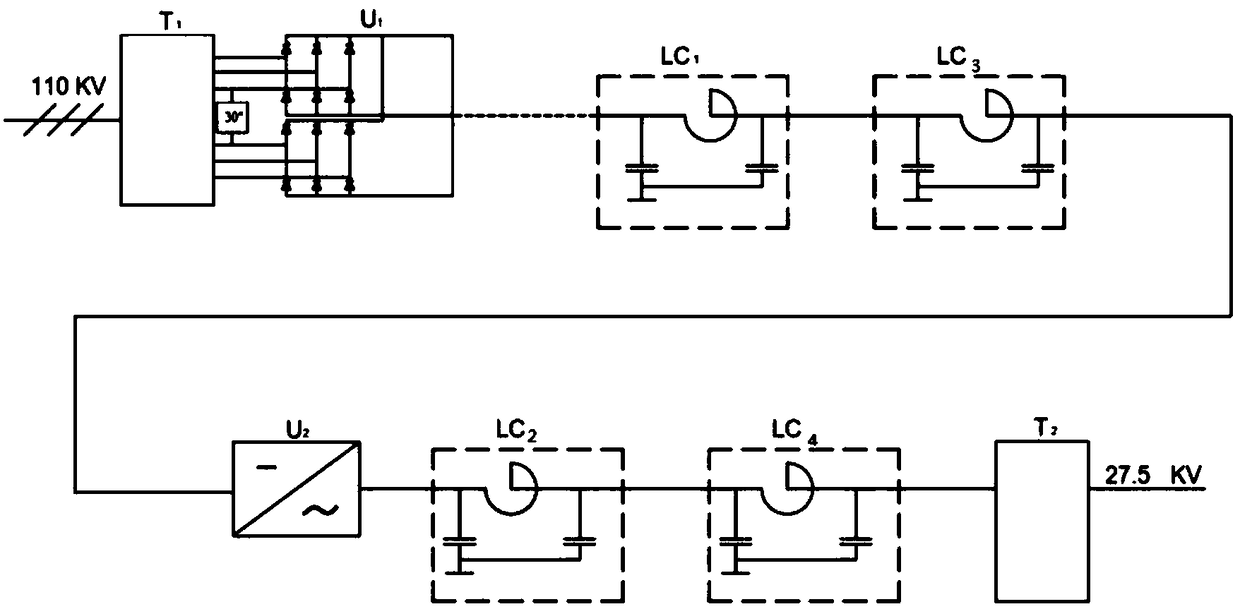Three-phase balanced electrified railway power supply system of power grid
A technology of electrified railway and three-phase balance, which is applied in the direction of reducing the asymmetry of the multi-phase network, eliminating/reducing the asymmetry of the multi-phase network, etc., can solve the problems that cannot be practically applied, and there is no anti-interference circuit, so as to improve reliability, Reduce the interference of clutter and ensure the effect of safe operation
- Summary
- Abstract
- Description
- Claims
- Application Information
AI Technical Summary
Problems solved by technology
Method used
Image
Examples
Embodiment 1
[0021] Such as figure 1 As shown, a three-phase balanced power supply electrified railway power supply system for the power grid includes successively connected step-down transformers (T 1 ), high voltage rectifier circuit (U 1 ), LC 1 filter circuit (LC 1 ), HVDC inverter (U 2 ), LC 2 filter circuit (LC 2 ) and step-up transformer (T 2 ). The LC 3 The filter circuit is connected in series with the LC 1 Between filter circuit and HVDC inverter, LC 4 filter circuit with LC 2 filter circuit in series, LC 4 The output terminal of the filter circuit is used as the output terminal of the circuit. The LC 1 filter circuit (LC 1 ) includes a first reactor, the two ends of the first reactor are respectively used as the input end and the output end, the input end and the output end of the first reactor are respectively connected with a capacitor, and the other end of the capacitor is grounded, so The input end of the first reactor and the high voltage rectifier circuit (U...
Embodiment 2
[0023] Such as figure 2 As shown, the difference from Example 1 is that the LC 1 filter circuit (LC 1 ) and LC 2 filter circuit (LC 2 ), the LC 1 filter circuit (LC 1 ) includes a third reactor, the two ends of the third reactor are respectively used as the input end and the output end, the input end of the third reactor is connected with a capacitor, the other end of the capacitor is grounded, and the third reactance The input terminal of the device and the high voltage rectifier circuit (U 1 ) is connected to the output end of the third reactor, and the output end of the third reactor is connected to the high voltage DC inverter (U 2 ) connected to the input. The LC 2 filter circuit (LC 2 ) includes a fourth reactor, the two ends of the fourth reactor serve as the input end and the output end respectively, the output end of the fourth reactor is connected with a capacitor, and the other end of the capacitor is grounded. The input terminal of the fourth reactor is ...
Embodiment 3
[0025] Such as image 3 As shown, a three-phase balanced power supply electrified railway power supply system for the power grid includes successively connected step-down transformers (T 1 ), high voltage rectifier circuit (U 1 ), LC 1 filter circuit (LC 1 ), LC 3 filter circuit (LC 3 ), HVDC inverter (U 2 ), LC 2 filter circuit (LC 2 ), LC 4 filter circuit (LC 4 ) and step-up transformer (T 2 ). The LC 1 filter circuit (LC 1 ) includes a first reactor and capacitors connected in series on both sides of the first reactor, the other end of the capacitor is grounded, and the LC 3The filter circuit includes a fifth reactor and capacitors connected in series on both sides of the fifth reactor, the first reactor and the fifth reactor are connected in series, the other end of the capacitor is grounded, and the first reactor The input terminal and the high voltage rectifier circuit (U 1 ) is connected to the output end of the fifth reactor, and the output end of the fi...
PUM
 Login to View More
Login to View More Abstract
Description
Claims
Application Information
 Login to View More
Login to View More - R&D
- Intellectual Property
- Life Sciences
- Materials
- Tech Scout
- Unparalleled Data Quality
- Higher Quality Content
- 60% Fewer Hallucinations
Browse by: Latest US Patents, China's latest patents, Technical Efficacy Thesaurus, Application Domain, Technology Topic, Popular Technical Reports.
© 2025 PatSnap. All rights reserved.Legal|Privacy policy|Modern Slavery Act Transparency Statement|Sitemap|About US| Contact US: help@patsnap.com



